Management Accounting Analysis: Costing, Budgeting, and Variance
VerifiedAdded on 2020/01/28
|24
|6349
|83
Report
AI Summary
This report delves into the core principles of management accounting, offering a comprehensive analysis of cost behavior, profitability, and performance evaluation. The report begins by classifying costs into fixed, variable, and semi-variable categories for Columbus Ltd and Steel Ltd, followed by the computation of gross profits for both companies, demonstrating the application of marginal and absorption costing methods. The analysis extends to identifying different types of expenditure and constructing costing reports to evaluate performance indicators, emphasizing methods to reduce costs and enhance value and quality. Budgeting is explored, including its purpose, various methods, and a demonstration of flexible budgeting. Furthermore, the report incorporates variance analysis, evaluating Yuri Cutlery's budget and providing an operating statement and a memorandum report. The report highlights the importance of cost management tools in making effective decisions, managing financial prospects, and improving overall business efficiency.
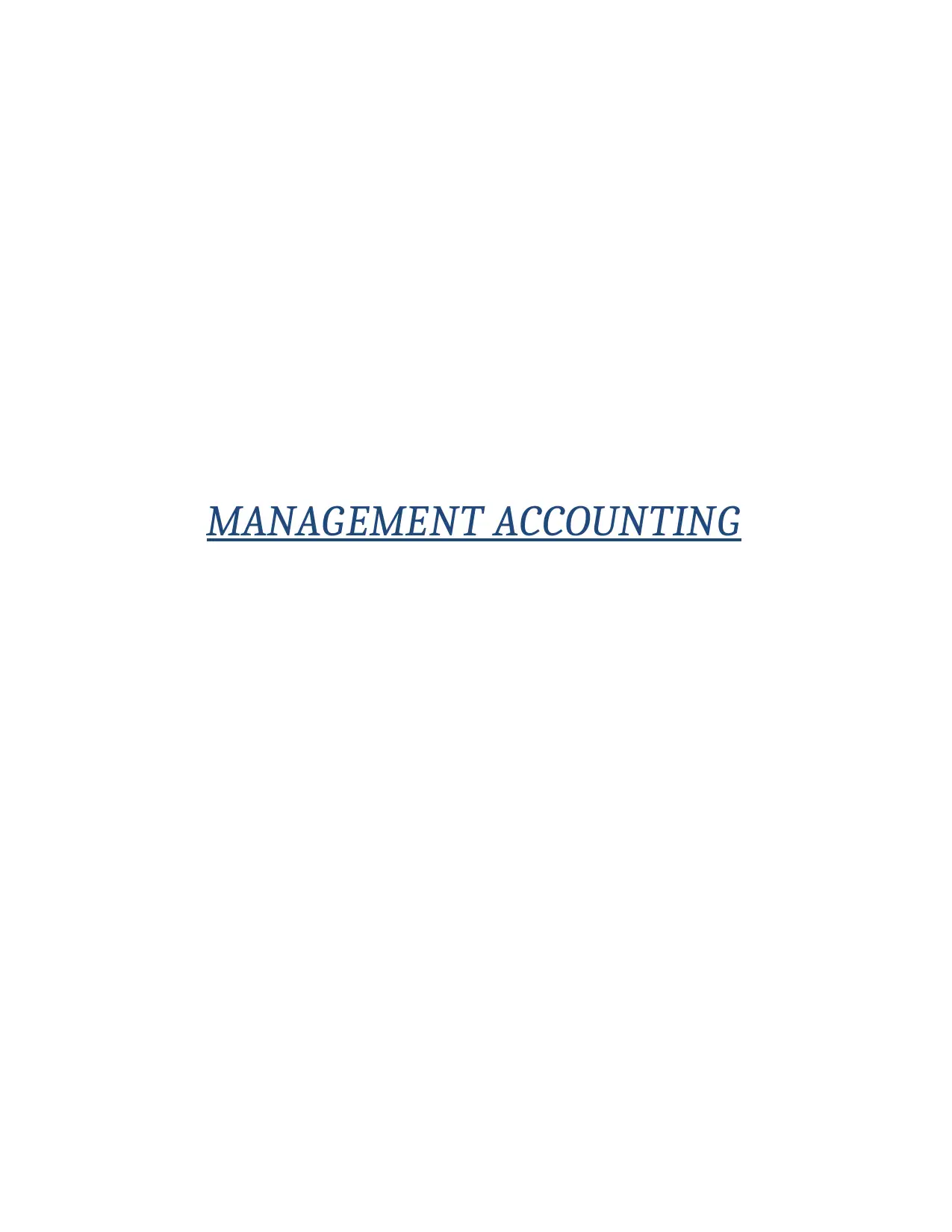
MANAGEMENT ACCOUNTING
Paraphrase This Document
Need a fresh take? Get an instant paraphrase of this document with our AI Paraphraser
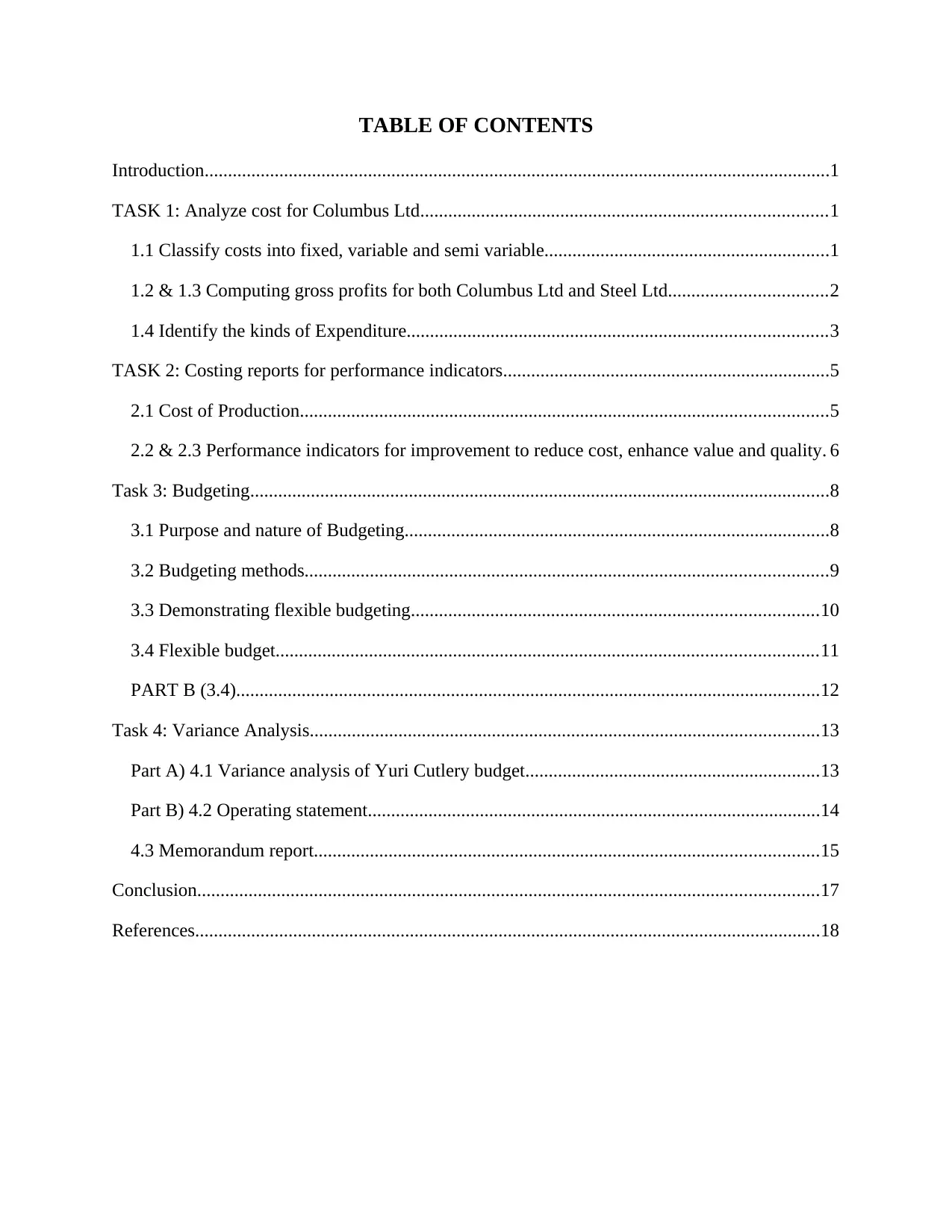
TABLE OF CONTENTS
Introduction......................................................................................................................................1
TASK 1: Analyze cost for Columbus Ltd.......................................................................................1
1.1 Classify costs into fixed, variable and semi variable.............................................................1
1.2 & 1.3 Computing gross profits for both Columbus Ltd and Steel Ltd..................................2
1.4 Identify the kinds of Expenditure..........................................................................................3
TASK 2: Costing reports for performance indicators......................................................................5
2.1 Cost of Production.................................................................................................................5
2.2 & 2.3 Performance indicators for improvement to reduce cost, enhance value and quality. 6
Task 3: Budgeting............................................................................................................................8
3.1 Purpose and nature of Budgeting...........................................................................................8
3.2 Budgeting methods................................................................................................................9
3.3 Demonstrating flexible budgeting.......................................................................................10
3.4 Flexible budget....................................................................................................................11
PART B (3.4).............................................................................................................................12
Task 4: Variance Analysis.............................................................................................................13
Part A) 4.1 Variance analysis of Yuri Cutlery budget...............................................................13
Part B) 4.2 Operating statement.................................................................................................14
4.3 Memorandum report............................................................................................................15
Conclusion.....................................................................................................................................17
References......................................................................................................................................18
Introduction......................................................................................................................................1
TASK 1: Analyze cost for Columbus Ltd.......................................................................................1
1.1 Classify costs into fixed, variable and semi variable.............................................................1
1.2 & 1.3 Computing gross profits for both Columbus Ltd and Steel Ltd..................................2
1.4 Identify the kinds of Expenditure..........................................................................................3
TASK 2: Costing reports for performance indicators......................................................................5
2.1 Cost of Production.................................................................................................................5
2.2 & 2.3 Performance indicators for improvement to reduce cost, enhance value and quality. 6
Task 3: Budgeting............................................................................................................................8
3.1 Purpose and nature of Budgeting...........................................................................................8
3.2 Budgeting methods................................................................................................................9
3.3 Demonstrating flexible budgeting.......................................................................................10
3.4 Flexible budget....................................................................................................................11
PART B (3.4).............................................................................................................................12
Task 4: Variance Analysis.............................................................................................................13
Part A) 4.1 Variance analysis of Yuri Cutlery budget...............................................................13
Part B) 4.2 Operating statement.................................................................................................14
4.3 Memorandum report............................................................................................................15
Conclusion.....................................................................................................................................17
References......................................................................................................................................18
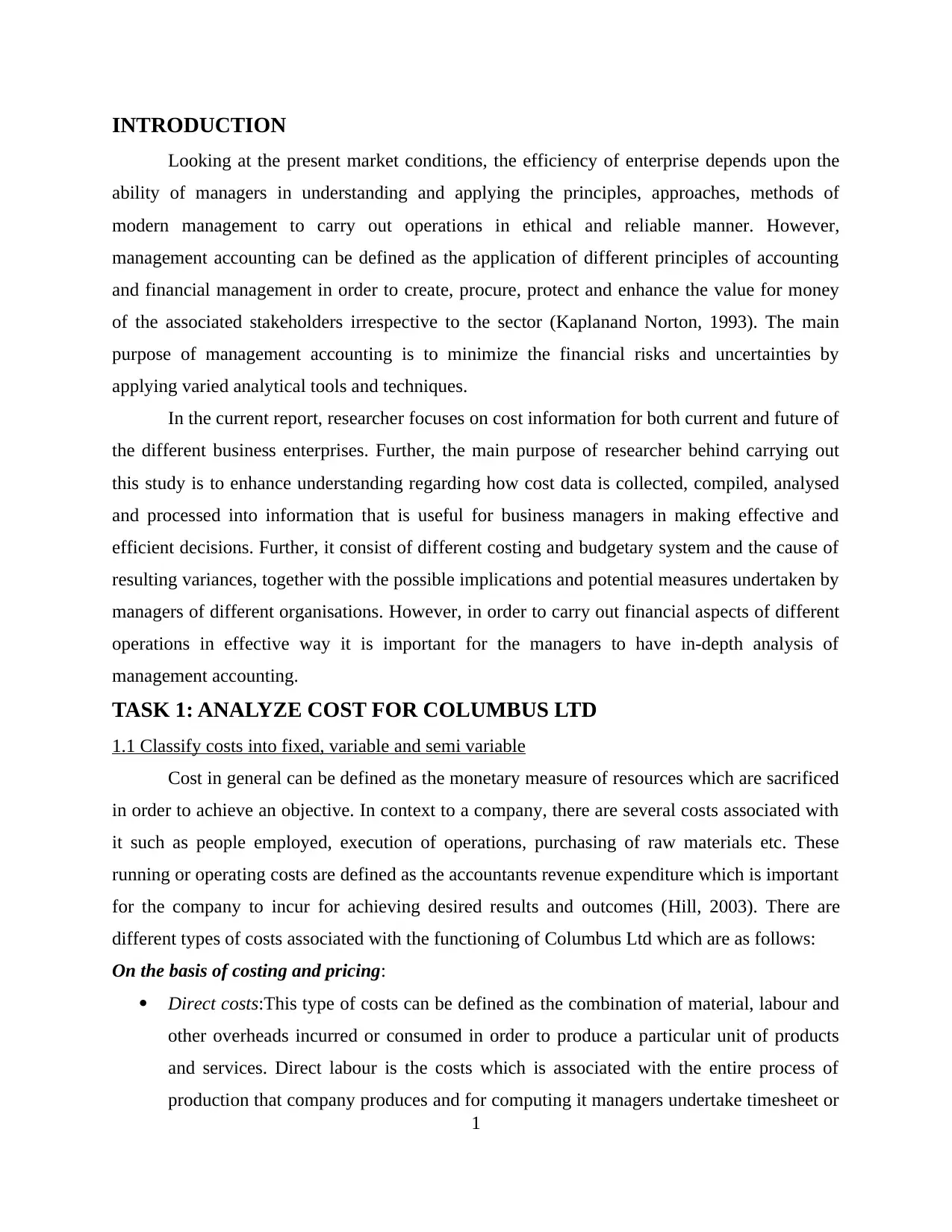
INTRODUCTION
Looking at the present market conditions, the efficiency of enterprise depends upon the
ability of managers in understanding and applying the principles, approaches, methods of
modern management to carry out operations in ethical and reliable manner. However,
management accounting can be defined as the application of different principles of accounting
and financial management in order to create, procure, protect and enhance the value for money
of the associated stakeholders irrespective to the sector (Kaplanand Norton, 1993). The main
purpose of management accounting is to minimize the financial risks and uncertainties by
applying varied analytical tools and techniques.
In the current report, researcher focuses on cost information for both current and future of
the different business enterprises. Further, the main purpose of researcher behind carrying out
this study is to enhance understanding regarding how cost data is collected, compiled, analysed
and processed into information that is useful for business managers in making effective and
efficient decisions. Further, it consist of different costing and budgetary system and the cause of
resulting variances, together with the possible implications and potential measures undertaken by
managers of different organisations. However, in order to carry out financial aspects of different
operations in effective way it is important for the managers to have in-depth analysis of
management accounting.
TASK 1: ANALYZE COST FOR COLUMBUS LTD
1.1 Classify costs into fixed, variable and semi variable
Cost in general can be defined as the monetary measure of resources which are sacrificed
in order to achieve an objective. In context to a company, there are several costs associated with
it such as people employed, execution of operations, purchasing of raw materials etc. These
running or operating costs are defined as the accountants revenue expenditure which is important
for the company to incur for achieving desired results and outcomes (Hill, 2003). There are
different types of costs associated with the functioning of Columbus Ltd which are as follows:
On the basis of costing and pricing:
Direct costs:This type of costs can be defined as the combination of material, labour and
other overheads incurred or consumed in order to produce a particular unit of products
and services. Direct labour is the costs which is associated with the entire process of
production that company produces and for computing it managers undertake timesheet or
1
Looking at the present market conditions, the efficiency of enterprise depends upon the
ability of managers in understanding and applying the principles, approaches, methods of
modern management to carry out operations in ethical and reliable manner. However,
management accounting can be defined as the application of different principles of accounting
and financial management in order to create, procure, protect and enhance the value for money
of the associated stakeholders irrespective to the sector (Kaplanand Norton, 1993). The main
purpose of management accounting is to minimize the financial risks and uncertainties by
applying varied analytical tools and techniques.
In the current report, researcher focuses on cost information for both current and future of
the different business enterprises. Further, the main purpose of researcher behind carrying out
this study is to enhance understanding regarding how cost data is collected, compiled, analysed
and processed into information that is useful for business managers in making effective and
efficient decisions. Further, it consist of different costing and budgetary system and the cause of
resulting variances, together with the possible implications and potential measures undertaken by
managers of different organisations. However, in order to carry out financial aspects of different
operations in effective way it is important for the managers to have in-depth analysis of
management accounting.
TASK 1: ANALYZE COST FOR COLUMBUS LTD
1.1 Classify costs into fixed, variable and semi variable
Cost in general can be defined as the monetary measure of resources which are sacrificed
in order to achieve an objective. In context to a company, there are several costs associated with
it such as people employed, execution of operations, purchasing of raw materials etc. These
running or operating costs are defined as the accountants revenue expenditure which is important
for the company to incur for achieving desired results and outcomes (Hill, 2003). There are
different types of costs associated with the functioning of Columbus Ltd which are as follows:
On the basis of costing and pricing:
Direct costs:This type of costs can be defined as the combination of material, labour and
other overheads incurred or consumed in order to produce a particular unit of products
and services. Direct labour is the costs which is associated with the entire process of
production that company produces and for computing it managers undertake timesheet or
1
⊘ This is a preview!⊘
Do you want full access?
Subscribe today to unlock all pages.

Trusted by 1+ million students worldwide
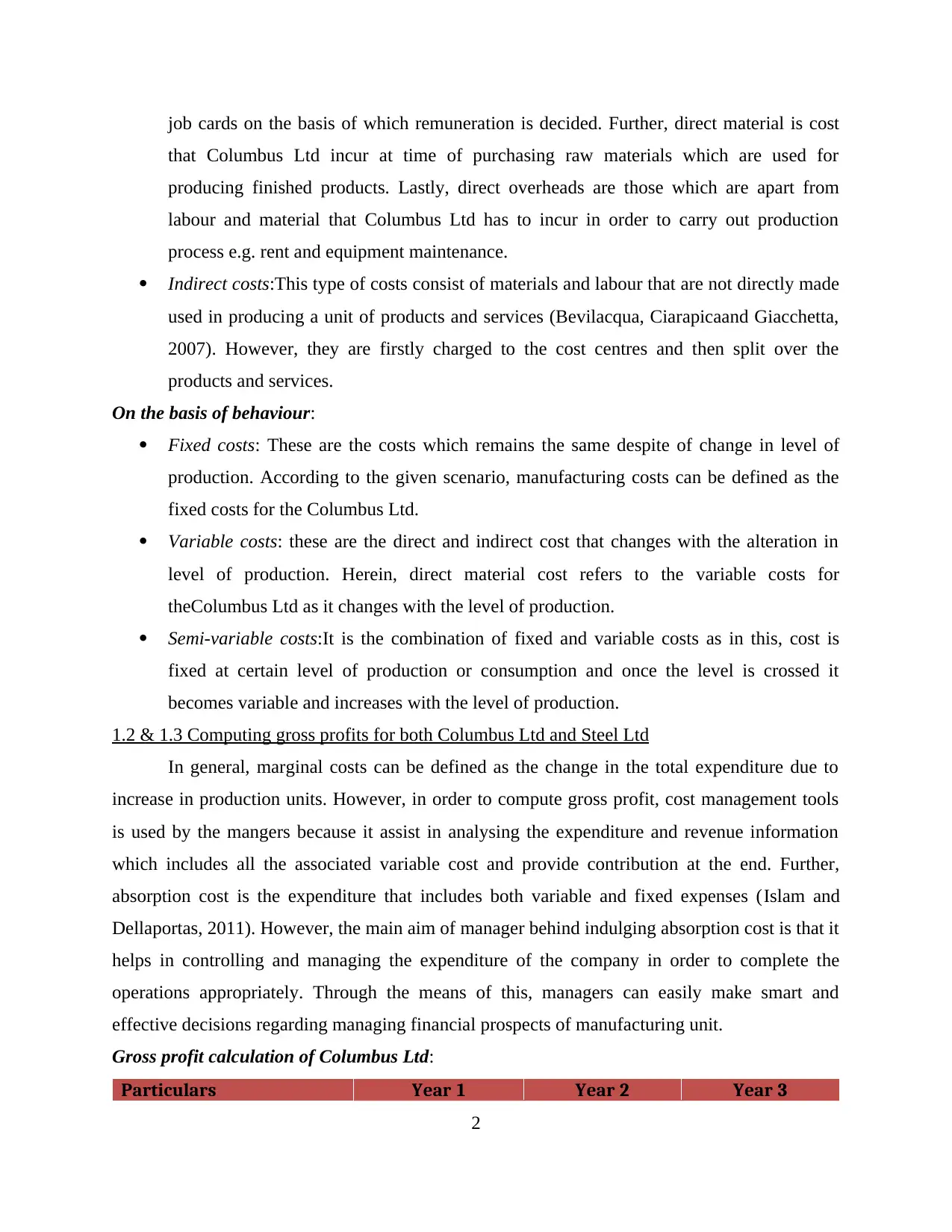
job cards on the basis of which remuneration is decided. Further, direct material is cost
that Columbus Ltd incur at time of purchasing raw materials which are used for
producing finished products. Lastly, direct overheads are those which are apart from
labour and material that Columbus Ltd has to incur in order to carry out production
process e.g. rent and equipment maintenance.
Indirect costs:This type of costs consist of materials and labour that are not directly made
used in producing a unit of products and services (Bevilacqua, Ciarapicaand Giacchetta,
2007). However, they are firstly charged to the cost centres and then split over the
products and services.
On the basis of behaviour:
Fixed costs: These are the costs which remains the same despite of change in level of
production. According to the given scenario, manufacturing costs can be defined as the
fixed costs for the Columbus Ltd.
Variable costs: these are the direct and indirect cost that changes with the alteration in
level of production. Herein, direct material cost refers to the variable costs for
theColumbus Ltd as it changes with the level of production.
Semi-variable costs:It is the combination of fixed and variable costs as in this, cost is
fixed at certain level of production or consumption and once the level is crossed it
becomes variable and increases with the level of production.
1.2 & 1.3 Computing gross profits for both Columbus Ltd and Steel Ltd
In general, marginal costs can be defined as the change in the total expenditure due to
increase in production units. However, in order to compute gross profit, cost management tools
is used by the mangers because it assist in analysing the expenditure and revenue information
which includes all the associated variable cost and provide contribution at the end. Further,
absorption cost is the expenditure that includes both variable and fixed expenses (Islam and
Dellaportas, 2011). However, the main aim of manager behind indulging absorption cost is that it
helps in controlling and managing the expenditure of the company in order to complete the
operations appropriately. Through the means of this, managers can easily make smart and
effective decisions regarding managing financial prospects of manufacturing unit.
Gross profit calculation of Columbus Ltd:
Particulars Year 1 Year 2 Year 3
2
that Columbus Ltd incur at time of purchasing raw materials which are used for
producing finished products. Lastly, direct overheads are those which are apart from
labour and material that Columbus Ltd has to incur in order to carry out production
process e.g. rent and equipment maintenance.
Indirect costs:This type of costs consist of materials and labour that are not directly made
used in producing a unit of products and services (Bevilacqua, Ciarapicaand Giacchetta,
2007). However, they are firstly charged to the cost centres and then split over the
products and services.
On the basis of behaviour:
Fixed costs: These are the costs which remains the same despite of change in level of
production. According to the given scenario, manufacturing costs can be defined as the
fixed costs for the Columbus Ltd.
Variable costs: these are the direct and indirect cost that changes with the alteration in
level of production. Herein, direct material cost refers to the variable costs for
theColumbus Ltd as it changes with the level of production.
Semi-variable costs:It is the combination of fixed and variable costs as in this, cost is
fixed at certain level of production or consumption and once the level is crossed it
becomes variable and increases with the level of production.
1.2 & 1.3 Computing gross profits for both Columbus Ltd and Steel Ltd
In general, marginal costs can be defined as the change in the total expenditure due to
increase in production units. However, in order to compute gross profit, cost management tools
is used by the mangers because it assist in analysing the expenditure and revenue information
which includes all the associated variable cost and provide contribution at the end. Further,
absorption cost is the expenditure that includes both variable and fixed expenses (Islam and
Dellaportas, 2011). However, the main aim of manager behind indulging absorption cost is that it
helps in controlling and managing the expenditure of the company in order to complete the
operations appropriately. Through the means of this, managers can easily make smart and
effective decisions regarding managing financial prospects of manufacturing unit.
Gross profit calculation of Columbus Ltd:
Particulars Year 1 Year 2 Year 3
2
Paraphrase This Document
Need a fresh take? Get an instant paraphrase of this document with our AI Paraphraser
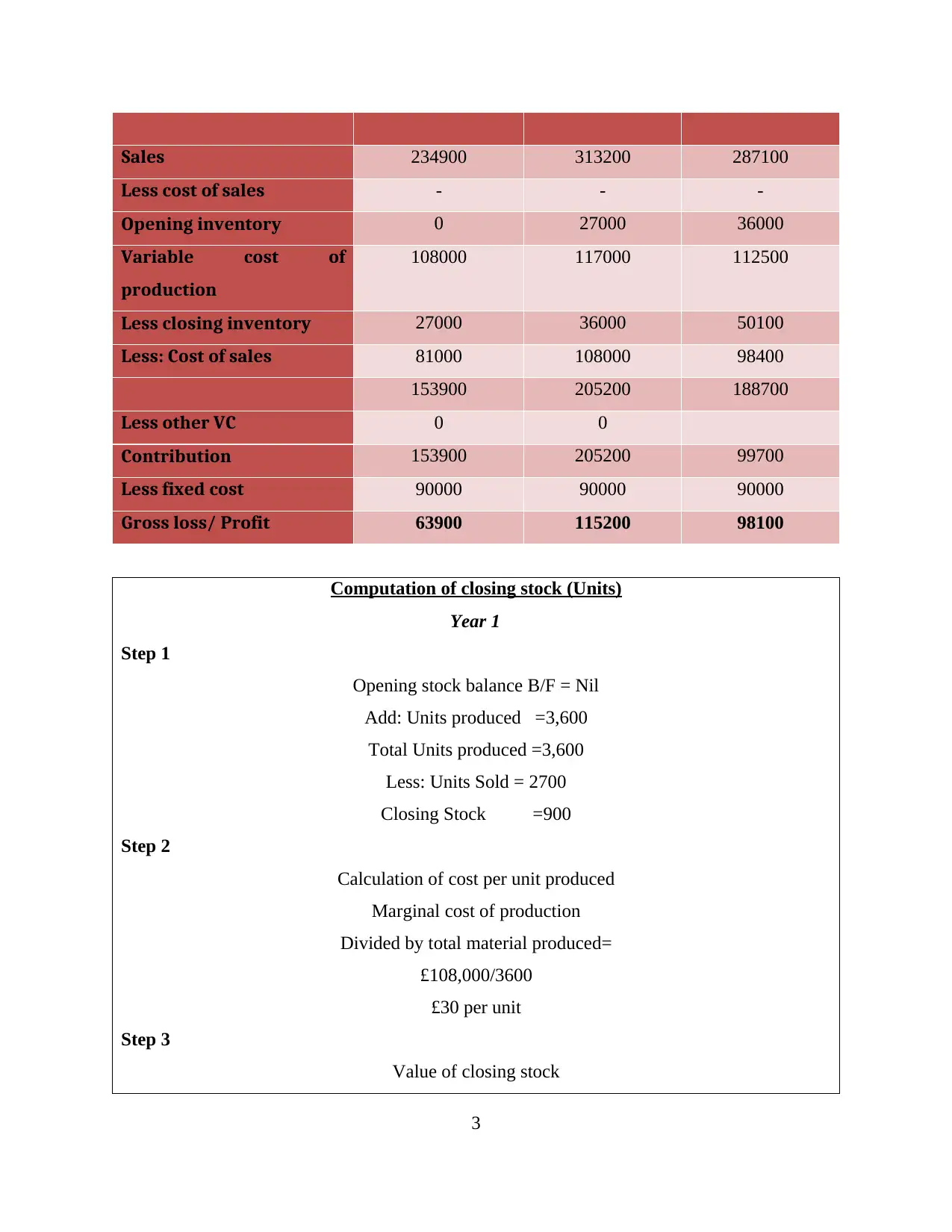
Sales 234900 313200 287100
Less cost of sales - - -
Opening inventory 0 27000 36000
Variable cost of
production
108000 117000 112500
Less closing inventory 27000 36000 50100
Less: Cost of sales 81000 108000 98400
153900 205200 188700
Less other VC 0 0
Contribution 153900 205200 99700
Less fixed cost 90000 90000 90000
Gross loss/ Profit 63900 115200 98100
Computation of closing stock (Units)
Year 1
Step 1
Opening stock balance B/F = Nil
Add: Units produced =3,600
Total Units produced =3,600
Less: Units Sold = 2700
Closing Stock =900
Step 2
Calculation of cost per unit produced
Marginal cost of production
Divided by total material produced=
£108,000/3600
£30 per unit
Step 3
Value of closing stock
3
Less cost of sales - - -
Opening inventory 0 27000 36000
Variable cost of
production
108000 117000 112500
Less closing inventory 27000 36000 50100
Less: Cost of sales 81000 108000 98400
153900 205200 188700
Less other VC 0 0
Contribution 153900 205200 99700
Less fixed cost 90000 90000 90000
Gross loss/ Profit 63900 115200 98100
Computation of closing stock (Units)
Year 1
Step 1
Opening stock balance B/F = Nil
Add: Units produced =3,600
Total Units produced =3,600
Less: Units Sold = 2700
Closing Stock =900
Step 2
Calculation of cost per unit produced
Marginal cost of production
Divided by total material produced=
£108,000/3600
£30 per unit
Step 3
Value of closing stock
3
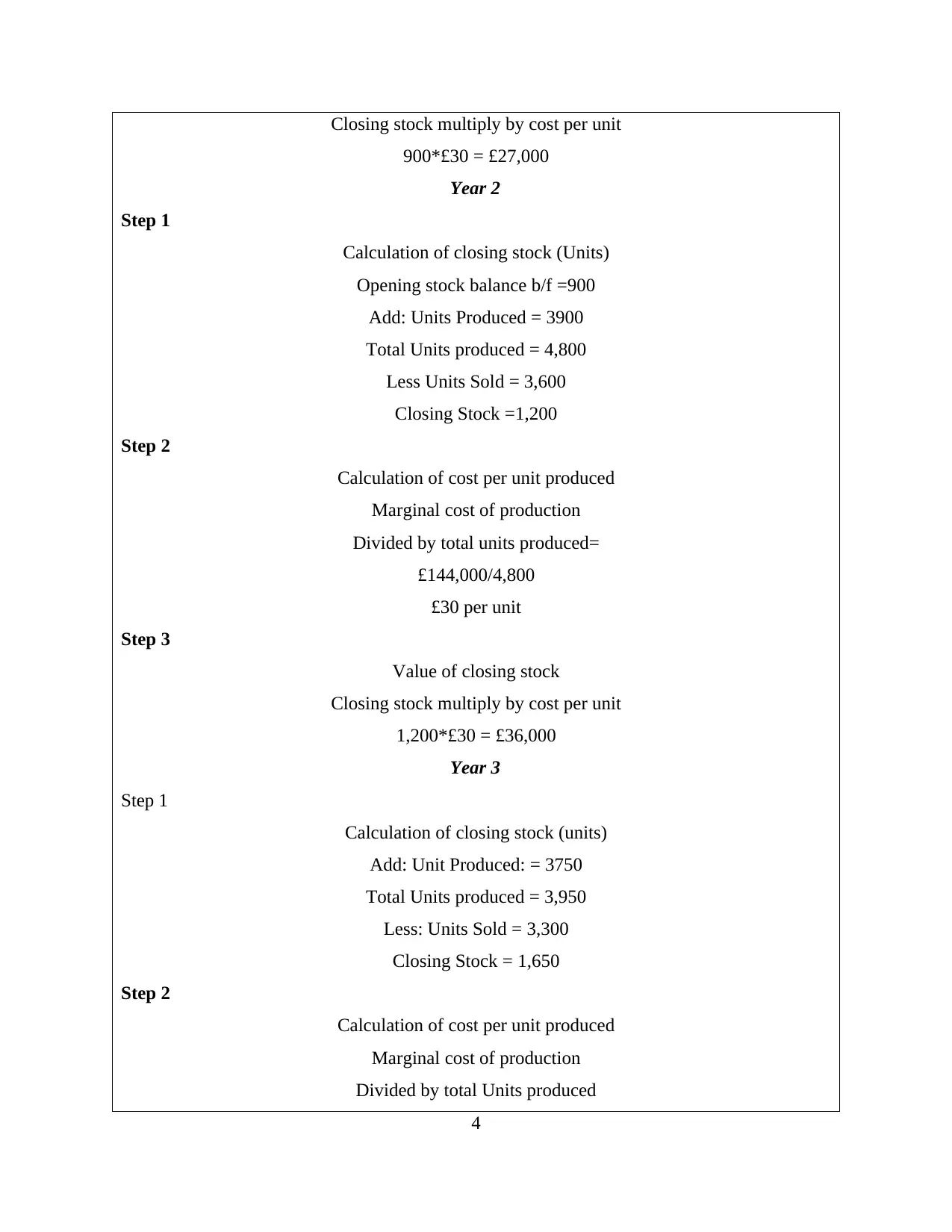
Closing stock multiply by cost per unit
900*£30 = £27,000
Year 2
Step 1
Calculation of closing stock (Units)
Opening stock balance b/f =900
Add: Units Produced = 3900
Total Units produced = 4,800
Less Units Sold = 3,600
Closing Stock =1,200
Step 2
Calculation of cost per unit produced
Marginal cost of production
Divided by total units produced=
£144,000/4,800
£30 per unit
Step 3
Value of closing stock
Closing stock multiply by cost per unit
1,200*£30 = £36,000
Year 3
Step 1
Calculation of closing stock (units)
Add: Unit Produced: = 3750
Total Units produced = 3,950
Less: Units Sold = 3,300
Closing Stock = 1,650
Step 2
Calculation of cost per unit produced
Marginal cost of production
Divided by total Units produced
4
900*£30 = £27,000
Year 2
Step 1
Calculation of closing stock (Units)
Opening stock balance b/f =900
Add: Units Produced = 3900
Total Units produced = 4,800
Less Units Sold = 3,600
Closing Stock =1,200
Step 2
Calculation of cost per unit produced
Marginal cost of production
Divided by total units produced=
£144,000/4,800
£30 per unit
Step 3
Value of closing stock
Closing stock multiply by cost per unit
1,200*£30 = £36,000
Year 3
Step 1
Calculation of closing stock (units)
Add: Unit Produced: = 3750
Total Units produced = 3,950
Less: Units Sold = 3,300
Closing Stock = 1,650
Step 2
Calculation of cost per unit produced
Marginal cost of production
Divided by total Units produced
4
⊘ This is a preview!⊘
Do you want full access?
Subscribe today to unlock all pages.

Trusted by 1+ million students worldwide
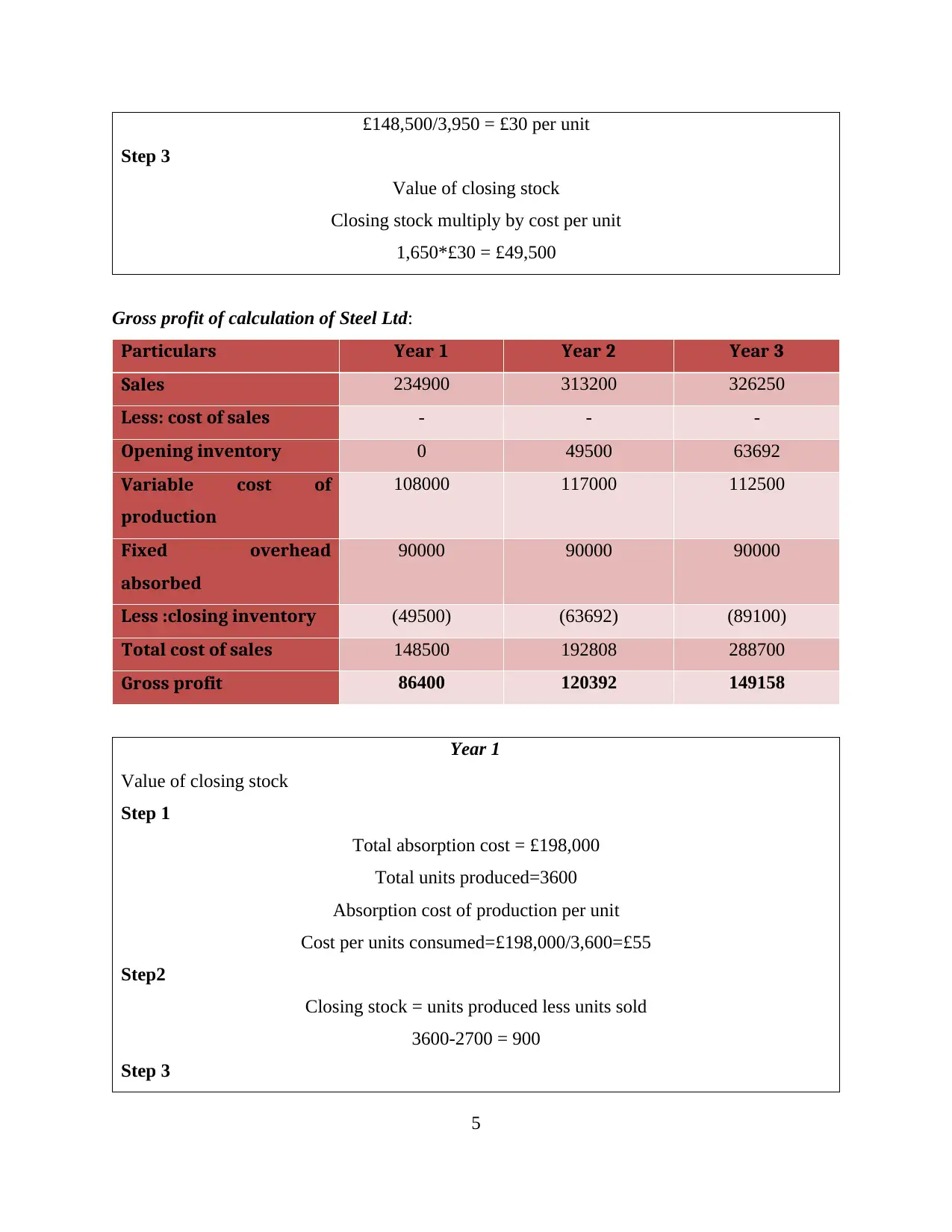
£148,500/3,950 = £30 per unit
Step 3
Value of closing stock
Closing stock multiply by cost per unit
1,650*£30 = £49,500
Gross profit of calculation of Steel Ltd:
Particulars Year 1 Year 2 Year 3
Sales 234900 313200 326250
Less: cost of sales - - -
Opening inventory 0 49500 63692
Variable cost of
production
108000 117000 112500
Fixed overhead
absorbed
90000 90000 90000
Less :closing inventory (49500) (63692) (89100)
Total cost of sales 148500 192808 288700
Gross profit 86400 120392 149158
Year 1
Value of closing stock
Step 1
Total absorption cost = £198,000
Total units produced=3600
Absorption cost of production per unit
Cost per units consumed=£198,000/3,600=£55
Step2
Closing stock = units produced less units sold
3600-2700 = 900
Step 3
5
Step 3
Value of closing stock
Closing stock multiply by cost per unit
1,650*£30 = £49,500
Gross profit of calculation of Steel Ltd:
Particulars Year 1 Year 2 Year 3
Sales 234900 313200 326250
Less: cost of sales - - -
Opening inventory 0 49500 63692
Variable cost of
production
108000 117000 112500
Fixed overhead
absorbed
90000 90000 90000
Less :closing inventory (49500) (63692) (89100)
Total cost of sales 148500 192808 288700
Gross profit 86400 120392 149158
Year 1
Value of closing stock
Step 1
Total absorption cost = £198,000
Total units produced=3600
Absorption cost of production per unit
Cost per units consumed=£198,000/3,600=£55
Step2
Closing stock = units produced less units sold
3600-2700 = 900
Step 3
5
Paraphrase This Document
Need a fresh take? Get an instant paraphrase of this document with our AI Paraphraser
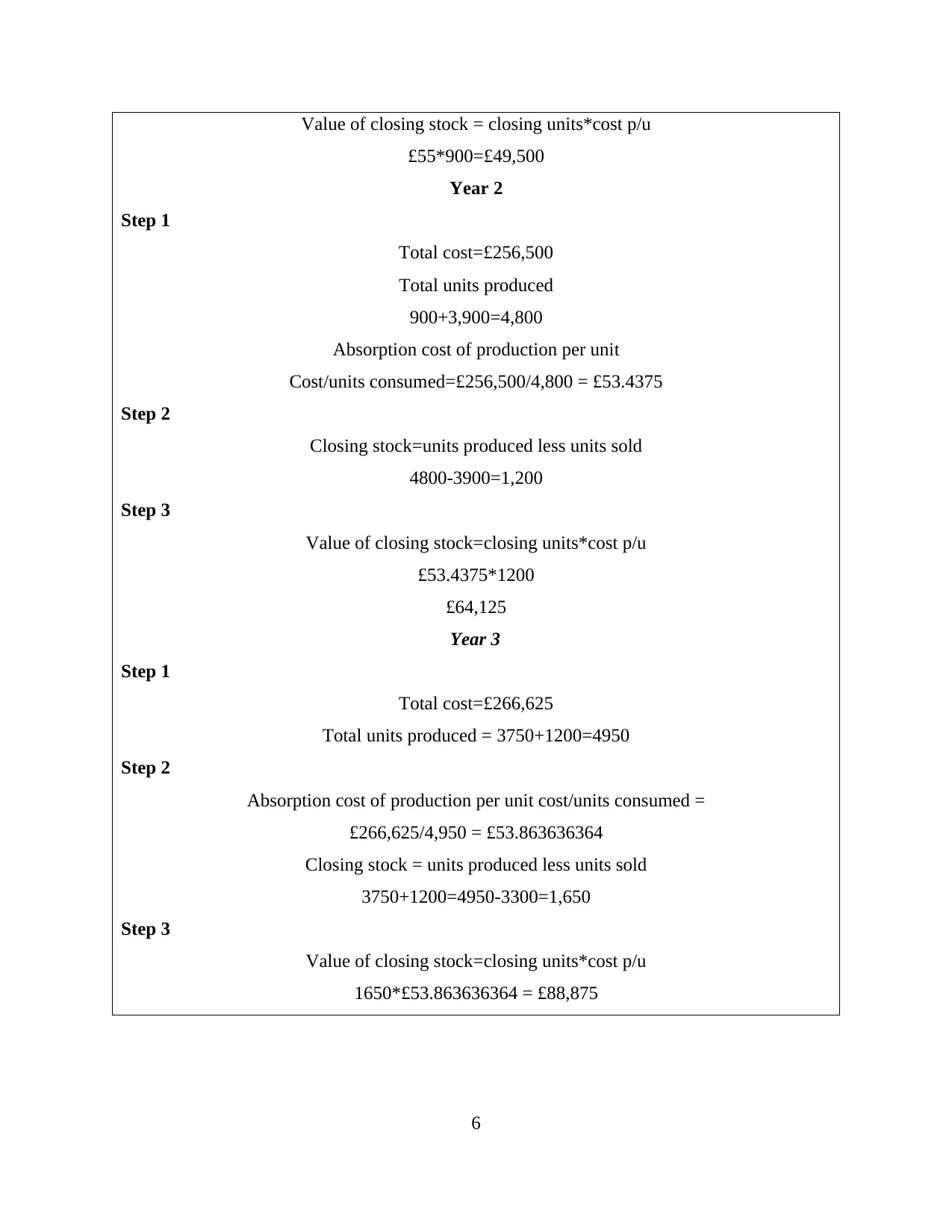
Value of closing stock = closing units*cost p/u
£55*900=£49,500
Year 2
Step 1
Total cost=£256,500
Total units produced
900+3,900=4,800
Absorption cost of production per unit
Cost/units consumed=£256,500/4,800 = £53.4375
Step 2
Closing stock=units produced less units sold
4800-3900=1,200
Step 3
Value of closing stock=closing units*cost p/u
£53.4375*1200
£64,125
Year 3
Step 1
Total cost=£266,625
Total units produced = 3750+1200=4950
Step 2
Absorption cost of production per unit cost/units consumed =
£266,625/4,950 = £53.863636364
Closing stock = units produced less units sold
3750+1200=4950-3300=1,650
Step 3
Value of closing stock=closing units*cost p/u
1650*£53.863636364 = £88,875
6
£55*900=£49,500
Year 2
Step 1
Total cost=£256,500
Total units produced
900+3,900=4,800
Absorption cost of production per unit
Cost/units consumed=£256,500/4,800 = £53.4375
Step 2
Closing stock=units produced less units sold
4800-3900=1,200
Step 3
Value of closing stock=closing units*cost p/u
£53.4375*1200
£64,125
Year 3
Step 1
Total cost=£266,625
Total units produced = 3750+1200=4950
Step 2
Absorption cost of production per unit cost/units consumed =
£266,625/4,950 = £53.863636364
Closing stock = units produced less units sold
3750+1200=4950-3300=1,650
Step 3
Value of closing stock=closing units*cost p/u
1650*£53.863636364 = £88,875
6
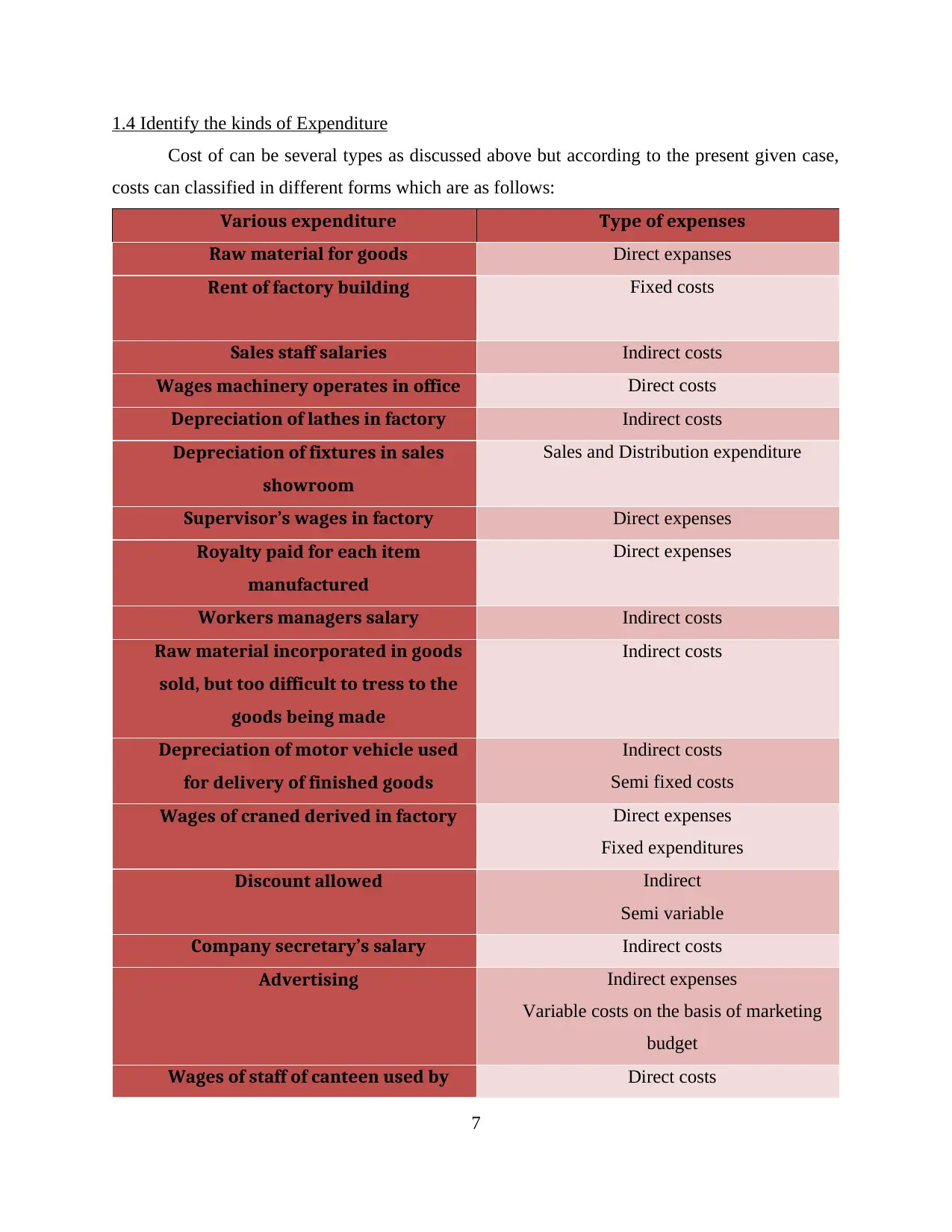
1.4 Identify the kinds of Expenditure
Cost of can be several types as discussed above but according to the present given case,
costs can classified in different forms which are as follows:
Various expenditure Type of expenses
Raw material for goods Direct expanses
Rent of factory building Fixed costs
Sales staff salaries Indirect costs
Wages machinery operates in office Direct costs
Depreciation of lathes in factory Indirect costs
Depreciation of fixtures in sales
showroom
Sales and Distribution expenditure
Supervisor’s wages in factory Direct expenses
Royalty paid for each item
manufactured
Direct expenses
Workers managers salary Indirect costs
Raw material incorporated in goods
sold, but too difficult to tress to the
goods being made
Indirect costs
Depreciation of motor vehicle used
for delivery of finished goods
Indirect costs
Semi fixed costs
Wages of craned derived in factory Direct expenses
Fixed expenditures
Discount allowed Indirect
Semi variable
Company secretary’s salary Indirect costs
Advertising Indirect expenses
Variable costs on the basis of marketing
budget
Wages of staff of canteen used by Direct costs
7
Cost of can be several types as discussed above but according to the present given case,
costs can classified in different forms which are as follows:
Various expenditure Type of expenses
Raw material for goods Direct expanses
Rent of factory building Fixed costs
Sales staff salaries Indirect costs
Wages machinery operates in office Direct costs
Depreciation of lathes in factory Indirect costs
Depreciation of fixtures in sales
showroom
Sales and Distribution expenditure
Supervisor’s wages in factory Direct expenses
Royalty paid for each item
manufactured
Direct expenses
Workers managers salary Indirect costs
Raw material incorporated in goods
sold, but too difficult to tress to the
goods being made
Indirect costs
Depreciation of motor vehicle used
for delivery of finished goods
Indirect costs
Semi fixed costs
Wages of craned derived in factory Direct expenses
Fixed expenditures
Discount allowed Indirect
Semi variable
Company secretary’s salary Indirect costs
Advertising Indirect expenses
Variable costs on the basis of marketing
budget
Wages of staff of canteen used by Direct costs
7
⊘ This is a preview!⊘
Do you want full access?
Subscribe today to unlock all pages.

Trusted by 1+ million students worldwide
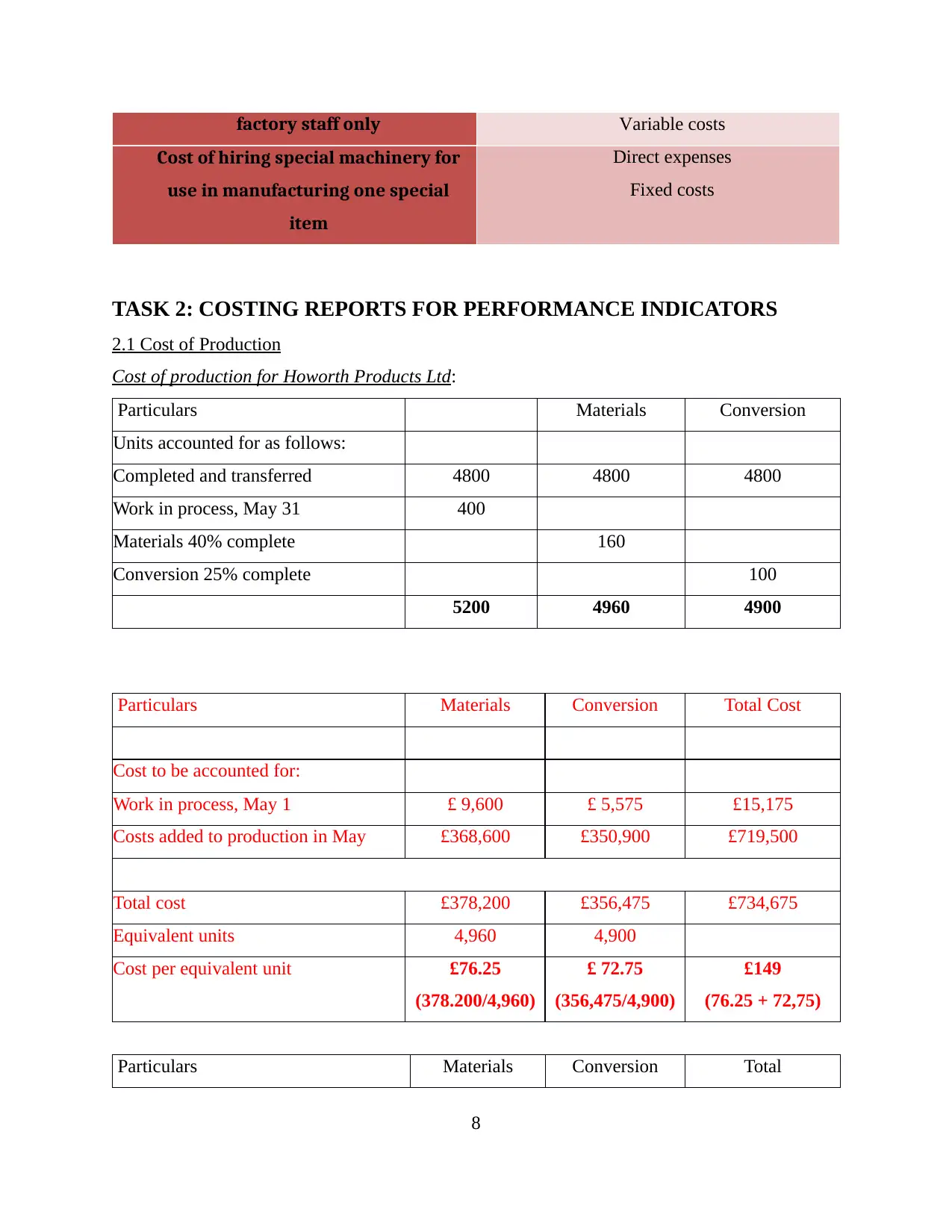
factory staff only Variable costs
Cost of hiring special machinery for
use in manufacturing one special
item
Direct expenses
Fixed costs
TASK 2: COSTING REPORTS FOR PERFORMANCE INDICATORS
2.1 Cost of Production
Cost of production for Howorth Products Ltd:
Particulars Materials Conversion
Units accounted for as follows:
Completed and transferred 4800 4800 4800
Work in process, May 31 400
Materials 40% complete 160
Conversion 25% complete 100
5200 4960 4900
Particulars Materials Conversion Total Cost
Cost to be accounted for:
Work in process, May 1 £ 9,600 £ 5,575 £15,175
Costs added to production in May £368,600 £350,900 £719,500
Total cost £378,200 £356,475 £734,675
Equivalent units 4,960 4,900
Cost per equivalent unit £76.25
(378.200/4,960)
£ 72.75
(356,475/4,900)
£149
(76.25 + 72,75)
Particulars Materials Conversion Total
8
Cost of hiring special machinery for
use in manufacturing one special
item
Direct expenses
Fixed costs
TASK 2: COSTING REPORTS FOR PERFORMANCE INDICATORS
2.1 Cost of Production
Cost of production for Howorth Products Ltd:
Particulars Materials Conversion
Units accounted for as follows:
Completed and transferred 4800 4800 4800
Work in process, May 31 400
Materials 40% complete 160
Conversion 25% complete 100
5200 4960 4900
Particulars Materials Conversion Total Cost
Cost to be accounted for:
Work in process, May 1 £ 9,600 £ 5,575 £15,175
Costs added to production in May £368,600 £350,900 £719,500
Total cost £378,200 £356,475 £734,675
Equivalent units 4,960 4,900
Cost per equivalent unit £76.25
(378.200/4,960)
£ 72.75
(356,475/4,900)
£149
(76.25 + 72,75)
Particulars Materials Conversion Total
8
Paraphrase This Document
Need a fresh take? Get an instant paraphrase of this document with our AI Paraphraser
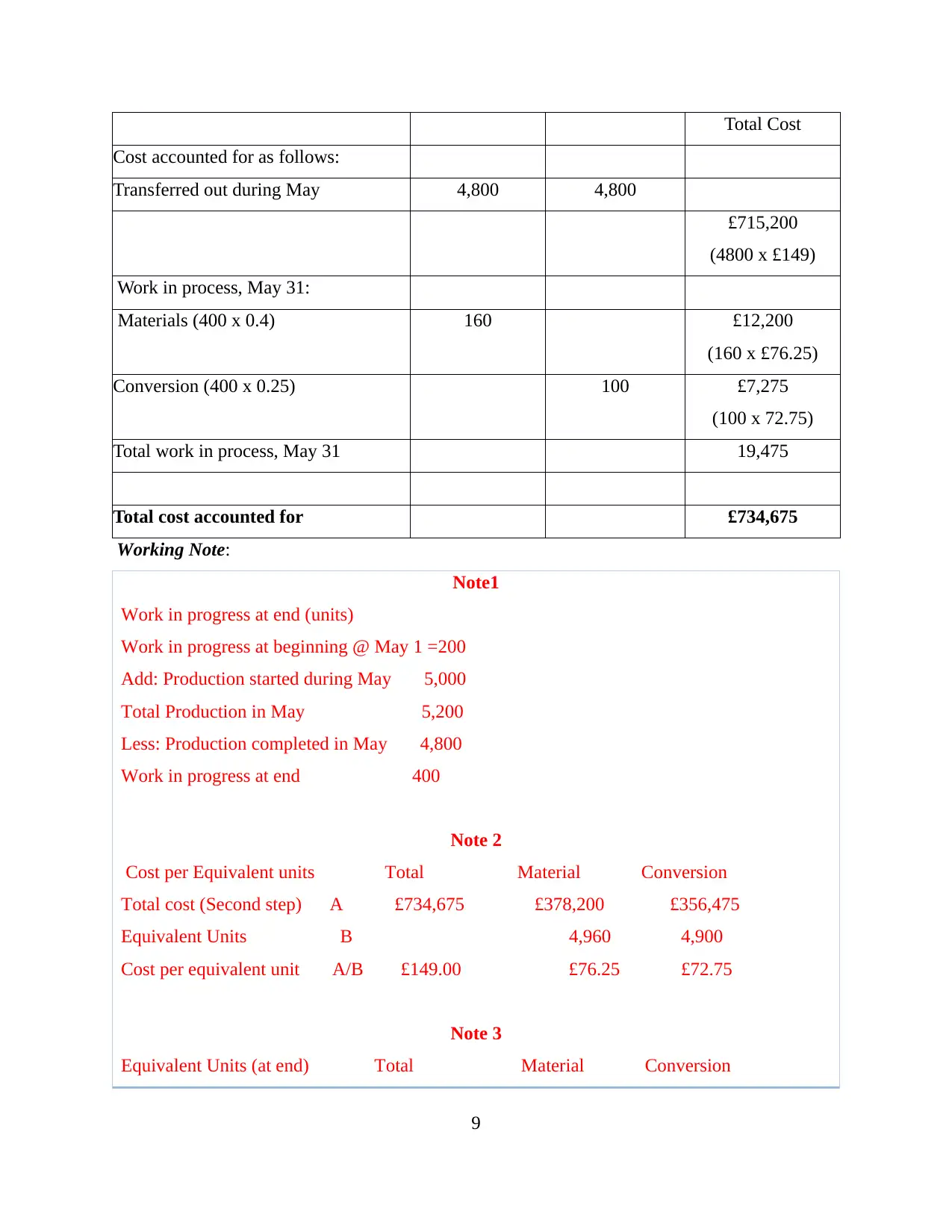
Total Cost
Cost accounted for as follows:
Transferred out during May 4,800 4,800
£715,200
(4800 x £149)
Work in process, May 31:
Materials (400 x 0.4) 160 £12,200
(160 x £76.25)
Conversion (400 x 0.25) 100 £7,275
(100 x 72.75)
Total work in process, May 31 19,475
Total cost accounted for £734,675
Working Note:
Note1
Work in progress at end (units)
Work in progress at beginning @ May 1 =200
Add: Production started during May 5,000
Total Production in May 5,200
Less: Production completed in May 4,800
Work in progress at end 400
Note 2
Cost per Equivalent units Total Material Conversion
Total cost (Second step) A £734,675 £378,200 £356,475
Equivalent Units B 4,960 4,900
Cost per equivalent unit A/B £149.00 £76.25 £72.75
Note 3
Equivalent Units (at end) Total Material Conversion
9
Cost accounted for as follows:
Transferred out during May 4,800 4,800
£715,200
(4800 x £149)
Work in process, May 31:
Materials (400 x 0.4) 160 £12,200
(160 x £76.25)
Conversion (400 x 0.25) 100 £7,275
(100 x 72.75)
Total work in process, May 31 19,475
Total cost accounted for £734,675
Working Note:
Note1
Work in progress at end (units)
Work in progress at beginning @ May 1 =200
Add: Production started during May 5,000
Total Production in May 5,200
Less: Production completed in May 4,800
Work in progress at end 400
Note 2
Cost per Equivalent units Total Material Conversion
Total cost (Second step) A £734,675 £378,200 £356,475
Equivalent Units B 4,960 4,900
Cost per equivalent unit A/B £149.00 £76.25 £72.75
Note 3
Equivalent Units (at end) Total Material Conversion
9
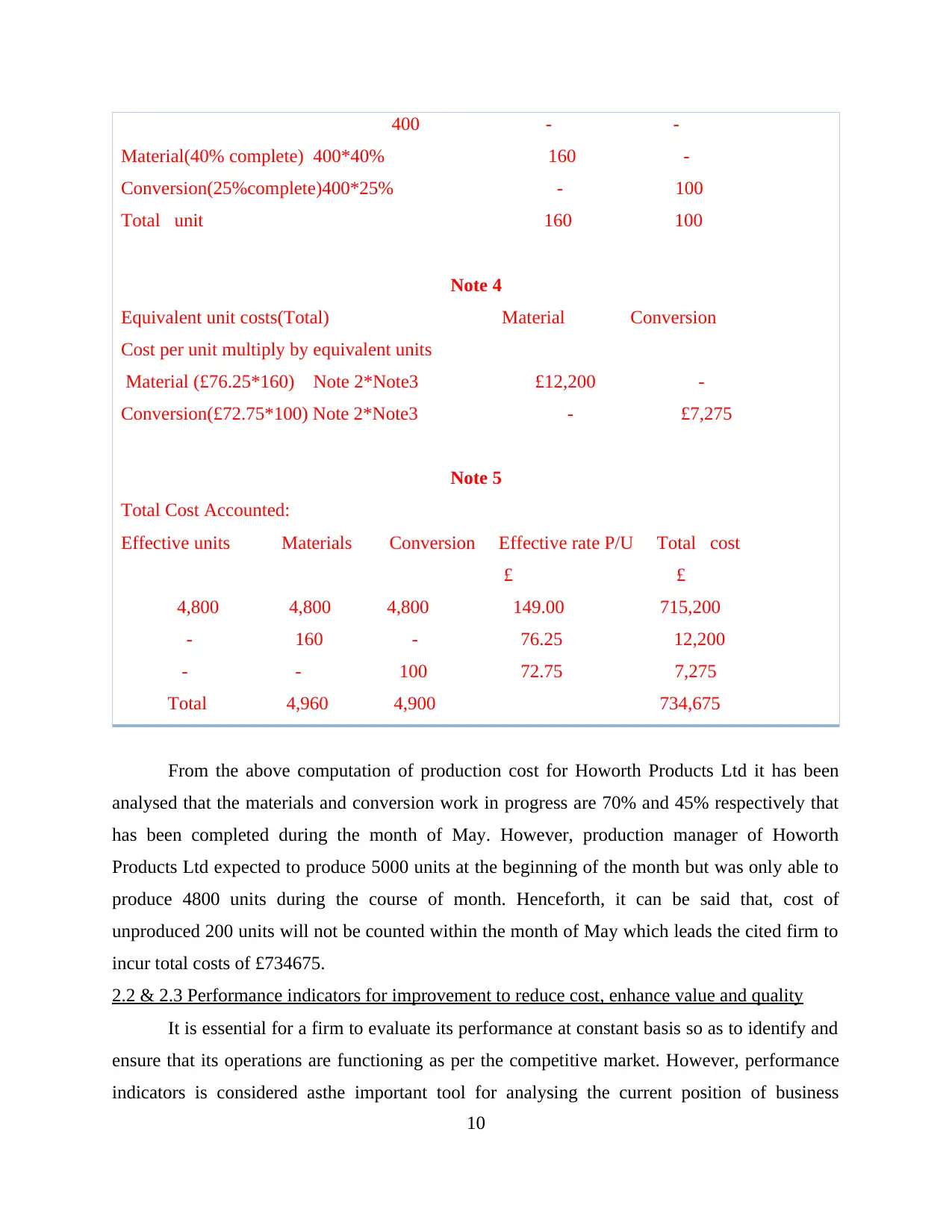
400 - -
Material(40% complete) 400*40% 160 -
Conversion(25%complete)400*25% - 100
Total unit 160 100
Note 4
Equivalent unit costs(Total) Material Conversion
Cost per unit multiply by equivalent units
Material (£76.25*160) Note 2*Note3 £12,200 -
Conversion(£72.75*100) Note 2*Note3 - £7,275
Note 5
Total Cost Accounted:
Effective units Materials Conversion Effective rate P/U Total cost
£ £
4,800 4,800 4,800 149.00 715,200
- 160 - 76.25 12,200
- - 100 72.75 7,275
Total 4,960 4,900 734,675
From the above computation of production cost for Howorth Products Ltd it has been
analysed that the materials and conversion work in progress are 70% and 45% respectively that
has been completed during the month of May. However, production manager of Howorth
Products Ltd expected to produce 5000 units at the beginning of the month but was only able to
produce 4800 units during the course of month. Henceforth, it can be said that, cost of
unproduced 200 units will not be counted within the month of May which leads the cited firm to
incur total costs of £734675.
2.2 & 2.3 Performance indicators for improvement to reduce cost, enhance value and quality
It is essential for a firm to evaluate its performance at constant basis so as to identify and
ensure that its operations are functioning as per the competitive market. However, performance
indicators is considered asthe important tool for analysing the current position of business
10
Material(40% complete) 400*40% 160 -
Conversion(25%complete)400*25% - 100
Total unit 160 100
Note 4
Equivalent unit costs(Total) Material Conversion
Cost per unit multiply by equivalent units
Material (£76.25*160) Note 2*Note3 £12,200 -
Conversion(£72.75*100) Note 2*Note3 - £7,275
Note 5
Total Cost Accounted:
Effective units Materials Conversion Effective rate P/U Total cost
£ £
4,800 4,800 4,800 149.00 715,200
- 160 - 76.25 12,200
- - 100 72.75 7,275
Total 4,960 4,900 734,675
From the above computation of production cost for Howorth Products Ltd it has been
analysed that the materials and conversion work in progress are 70% and 45% respectively that
has been completed during the month of May. However, production manager of Howorth
Products Ltd expected to produce 5000 units at the beginning of the month but was only able to
produce 4800 units during the course of month. Henceforth, it can be said that, cost of
unproduced 200 units will not be counted within the month of May which leads the cited firm to
incur total costs of £734675.
2.2 & 2.3 Performance indicators for improvement to reduce cost, enhance value and quality
It is essential for a firm to evaluate its performance at constant basis so as to identify and
ensure that its operations are functioning as per the competitive market. However, performance
indicators is considered asthe important tool for analysing the current position of business
10
⊘ This is a preview!⊘
Do you want full access?
Subscribe today to unlock all pages.

Trusted by 1+ million students worldwide
1 out of 24
Related Documents
Your All-in-One AI-Powered Toolkit for Academic Success.
+13062052269
info@desklib.com
Available 24*7 on WhatsApp / Email
![[object Object]](/_next/static/media/star-bottom.7253800d.svg)
Unlock your academic potential
Copyright © 2020–2025 A2Z Services. All Rights Reserved. Developed and managed by ZUCOL.





